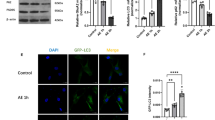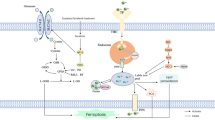Abstract
The aim of this study was to investigate the relationship between cell cycle reentry and apoptosis in cultured cortical neurons following oxygen–glucose deprivation (OGD). We found that the percentage of neurons with BrdU uptake, TUNEL staining, and colocalized BrdU uptake and TUNEL staining was increased relative to control 6, 12 and 24 h after 1 h of OGD. The number of neurons with colocalized BrdU and TUNEL staining was decreased relative to the number of TUNEL-positive neurons at 24 h. The expression of phosphorylated retinoblastoma protein (phospho-Rb) was significantly increased 6, 12 and 24 h after OGD, parallel with the changes in BrdU uptake. Phospho-Rb and TUNEL staining were colocalized in neurons 6 and 12 h after OGD. This colocalization was strikingly decreased 24 h after OGD. Treatment with the cyclin-dependent kinase inhibitor roscovitine (100 μM) decreased the expression of phospho-Rb and reduced neuronal apoptosis in vitro. These results demonstrated that attempted cell cycle reentry with phosphorylation of Rb induce early apoptosis in neurons after OGD and there must be other mechanisms involved in the later stages of neuronal apoptosis besides cell cycle reentry. Phosphoralated Rb may be an important factor which closely associates aberrant cell cycle reentry with the early stages of neuronal apoptosis following ischemia/hypoxia in vitro, and pharmacological interventions for neuroprotection may be useful directed at this keypoint.




Similar content being viewed by others
References
Okano HJ, Pfaff DW, Gibbs RB (1993) RB and Cdc2 expression in brain: correlations with 3H-thymidine incorporation and neurogenesis. J Neurosci 13:2930–2938
Nguyen MD, Mushynski WE, Julien JP (2002) Cycling at the interface between neurodevelopment and neurodegeneration. Cell Death Differ 9:1294–1306
Wartiovaara K, Barnabe-Heider F, Miller FD et al (2002) N-myc promotes survival and induces S-phase entry of postmitotic sympathetic neurons. J Neurosci 22:815–824
Osuga H, Osuga S, Wang F et al (2000) Cyclin-dependent kinases as a therapeutic target for stroke. Proc Natl Acad Sci USA 97:10254–10259
Wen Y, Yang S, Liu R et al (2005) Cell-cycle regulators are involved in transient cerebral ischemia induced neuronal apoptosis in female rats. FEBS Lett 79:4591–4599
Kuan CY, Schloemer AJ, Lu A et al (2004) Hypoxia-ischemia induces DNA synthesis without cell proliferation in dying neurons in adult rodent brain. J Neurosci 24:10763–10772
Vermeulen K, Berneman ZN, Van Bockstaele DR (2003) Cell cycle and apoptosis. Cell Prolif 36:165–175
Liu DX, Greene LA (2001) Neuronal apoptosis at the G1/S cell cycle checkpoint. Cell Tissue Res 305:217–228
Weinberg RA (1995) The retinoblastoma protein and cell cycle control. Cell 81:323–330
Dimova DK, Dyson NJ (2005) The E2F transcriptional network: old acquaintances with new faces. Oncogene 24:2810–2826
Balciunaite E, Spektor A, Lents NH et al (2005) Pocket protein complexes are recruited to distinct targets in quiescent and proliferating cells. Mol Cell Biol 25:8166–8178
Greene LA, Liu DX, Troy CM et al (2007) Cell cycle molecules define a pathway required for neuron death in development and disease. Biochim Biophys Acta 1772:392–401
Lee EY, Hu N, Yuan SS et al (1994) Dual roles of the retinoblastoma protein in cell cycle regulation and neuron differentiation. Genes Dev 8:2008–2021
Hayashi T, Sakai K, Sasaki C et al (2000) Phosphorylation of retinoblastoma protein in rat brain after transient middle cerebral artery occlusion. Neuropathol Appl Neurobiol 26:390–397
Rashidian J, Iyirhiaro G, Aleyasin H et al (2005) Multiple cyclin-dependent kinases signals are critical mediators of ischemia/hypoxic neuronal death in vitro and in vivo. Proc Natl Acad Sci USA 102:14080–14085
Yu Y, Luo X, Ren QG et al (2009) The involvement of upregulation and translocation of phospho-Rb in early neuronal apoptosis following focal cerebral ischemia in rats. Neurochem Res 34:1113–1119
Lossi L, Merighi A (2003) In vivo cellular and molecular mechanisms of neuronal apoptosis in the mammalian CNS. Prog Neurobiol 69:287–312
Gwag BJ, Lobner D, Koh JY et al (1995) Blockade of glutamate receptors unmasks neuronal apoptosis after oxygen glucose deprivation in vitro. Neuroscience 68:615–619
Gong QH, Wang Q, Shi JS et al (2007) Inhibition of caspases and intracellular free Ca2 + concentrations are involved in resveratrol protection against apoptosis in rat primary neuron cultures. Acta Pharmacol Sin 28:1724–1730
Lin SH, Vincent A, Shaw T et al (2000) Prevention of nitric oxide-induced neuronal injury through the modulation of independent pathways of programmed cell death. J Cereb Blood Flow Metab 20:1380–1391
Maiese K, Vincent AM (2000) Membrane asymmetry and DNA degradation: functionally distinct determinants of neuronal programmed cell death. J Neurosci Res 59:568–580
Connell-Crowley L, Harper JWGoodrich DW (1997) Cyclin D1/Cdk 4 regulates retinoblastoma protein-mediated cell cycle arrest by site-specific phosphorylation. Mol Biol Cell 8:287–301
Pan W, Sun T, Hoess R et al (1998) Defining the minimal portion of the retinoblastoma protein that serves as an efficient substrate for cdk4 kinase/cyclin D1 complex. Carcinogenesis 19:765–769
Kitagawa M, Higashi H, Jung HK et al (1996) The consensus motif for phosphorylation by cyclin D1-Cdk4 is different from that for phosphorylation by cyclinA/E-Cdk2. EMBO J 15:7060–7069
Ranganathan S, Bowser R (2003) Alterations in G(1) to S phase cell-cycle regulators during amyotrophic lateral sclerosis. Am J Pathol 162:823–835
Meijer L, Raymond E (2003) Roscovitine and other purines as kinase inhibitors: From starfish oocytes to clinical trials. Acc Chem Res 36:417–425
Byrnes KR, Faden AI (2007) Role of cell cycle proteins in CNS injury. Neurochem Res 32:1799–1807
Dick FA, Dyson N (2003) pRB contains an E2F1-specific binding domain that allows E2F1-induced apoptosis to be regulated separately from other E2F activities. Mol Cell 12:639–649
Denchi EL, Helin K (2005) E2F1 is crucial for E2F-dependent apoptosis. EMBO Rep 6:661–668
Nguyen MD, Boudreau M, Kriz J et al (2003) Cell cycle regulators in the neuronal death pathway of amyotrophic lateral sclerosis caused by mutant superoxide dismutase 1. J Neurosci 23:2131–2140
Park DS, Obeidat A, Giovanni A et al (2000) Cell cycle regulators in neuronal death evoked by excitotoxic stress: implications for neurodegeneration and its treatment. Neurobiol Aging 21:771–781
Jordan-Sciutto KL, Malaiyandi LM, Bowser R (2002) Altered distribution of cell cycle transcriptional regulators during Alzheimer disease. J Neuropathol Exp Neurol 61:358–367
Panickar KS, Nonner D, White MG et al (2008) Overexpression of Cdk5 or non-phosphorylatable retinoblastoma protein protects septal neurons from oxygen-glucose deprivation. Neurochem Res 33:1852–1858
Wang W, Redecker C, Bidmon HJ et al (2004) Delayed neuronal death and damage of GDNF family receptors in CA1 following focal cerebral ischemia. Brain Res 1023:92–101
Cho BB, Toledo-Pereyra LH (2008) Caspase-independent programmed cell death following ischemic stroke. J Invest Surg 21:141–147
Acknowledgments
This work was supported by National Science Fund for Distinguished Young Scholars (30725019) and the National Natural Science Foundation of China (30900447).
Author information
Authors and Affiliations
Corresponding author
Additional information
Ying Yu and Qing-Guo Ren contributed equally to this work.
Electronic supplementary material
Below is the link to the electronic supplementary material.
Rights and permissions
About this article
Cite this article
Yu, Y., Ren, QG., Zhang, ZH. et al. Phospho-Rb Mediating Cell Cycle Reentry Induces Early Apoptosis Following Oxygen–Glucose Deprivation in Rat Cortical Neurons. Neurochem Res 37, 503–511 (2012). https://doi.org/10.1007/s11064-011-0636-6
Received:
Revised:
Accepted:
Published:
Issue Date:
DOI: https://doi.org/10.1007/s11064-011-0636-6




